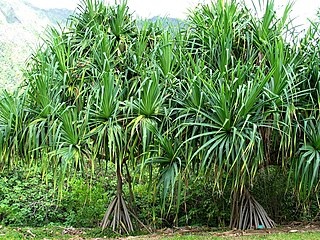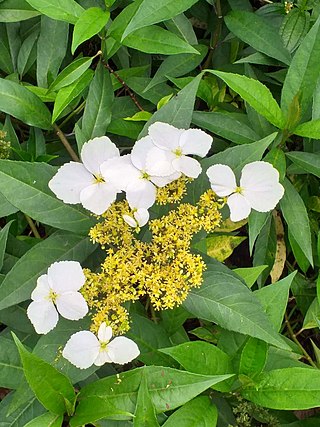
Chives, scientific name Allium schoenoprasum, is a species of flowering plant in the family Amaryllidaceae that produces edible leaves and flowers. Their close relatives include the common onions, garlic, shallot, leek, scallion, and Chinese onion.

The Piperaceae, also known as the pepper family, are a large family of flowering plants. The group contains roughly 3,600 currently accepted species in 5 genera. The vast majority of species can be found within the two main genera: Piper and Peperomia.

Triadenum, known as marsh St. John's worts, is a small genus of flowering plants in the family Hypericaceae. The genus is characterized by opposite, blunt-tipped leaves and pink flowers with 9 stamens. They are distributed in North America and eastern Asia.

Pandanaceae is a family of flowering plants native to the tropics and subtropics of the Old World, from West Africa through the Pacific. It contains 982 known species in five genera, of which the type genus, Pandanus, is the most important, with species like Pandanus amaryllifolius and karuka being important sources of food. The family likely originated during the Late Cretaceous.

Centaurea cineraria, the velvet centaurea, also known as dusty miller and silver dust, is a species of flowering plant in the family Asteraceae endemic to southern Italy. In natural settings, it grows on coastal cliffs, ranging from 0–350 m above sea level, hence the plant's Italian name, fiordaliso delle scogliere. Mature plants may reach 80 centimetres (31.5 in) in height. The species produces purple flowers.
Aralia hypoglauca is a species of flowering plant in the family Araliaceae. It is an epiphytic shrub native to Guangxi and southwestern Hunan provinces of China. It has been treated as the only species Hunaniopanax hypoglaucus of the genus Hunanioglaucus.
Begonia cavaleriei is a species of plant in the family Begoniaceae. It is endemic to China. It grows on limestone rocks.
Begonia hainanensis is a species of plant in the family Begoniaceae. It is endemic to China. It grows in forests and on mossy rocks.
Begonia peltatifolia is a species of plant in the family Begoniaceae. It is endemic to China. It grows on limestone rocks and broad-leaved forests.

Butomus is the only known genus in the plant family Butomaceae, native to Europe and Asia. It is considered invasive in some parts of the United States.

Boenninghausenia is a monotypic plant genus in the family Rutaceae. The sole species is Boenninghausenia albiflora, which occurs in Bhutan, Nepal, Pakistan, Kashmir, India, Indonesia, Philippines, Myanmar, Thailand, Laos, North Vietnam, China and Japan.

Hydrangea chinensis is a species of flowering plant in the family Hydrangeaceae, native to Myanmar, southeast China, and Taiwan. It grows in valleys and on mountain tops and slopes.
Hydrangea chungii is a species of flowering plant in the family Hydrangeaceae, native to southeast China. It was formally described by Alfred Rehder in 1931. It is a small shrub that grows up to 0.7 m (2.3 ft) tall.
Flora of China is a scientific publication aimed at describing the plants native to China.

Najas gracillima, the slender waternymph, is a submerged species of aquatic plant in the Hydrocharitaceae family. found in lakes and streams. It is native to China, Russian Far East, Japan, Korea, Taiwan, Iran, Alberta, Ontario, Newfoundland, Nova Scotia, New Brunswick, the eastern United States. It is also considered introduced and naturalized in France, Spain, Italy and California.

Sagittaria pygmaea, commonly known as the dwarf arrowhead or pygmy arrowhead, is an aquatic plant species. It is a perennial herb producing by means of stolons. Leaves are linear to slightly spatula-shaped, not lobed, up to 30 centimetres long.

Crepidiastrum sonchifolium, the sonchus-leaf crepidiastrum, is a flowering plant in the family Asteraceae. It is native to East Asia, and is cultivated in Korea. Crepidiastrum sonchifolium is an annual or biennial herb that grows 20–100 cm (7.9–39.4 in) tall. It grows in a variety of habitats including grasslands on mountain slopes, thickets, rocky stream beds, cliffs, and roadsides.

Polygala tatarinowii is a species of flowering plant in the milkwort family (Polygalaceae). It is native to China, Japan, Korea, Russia, Myanmar, the Philippines, Taiwan, and Vietnam. It is a herb that grows up to 15 cm (5.9 in) tall.

Vitis bellula, commonly known as the beautiful grape or small leaf hair grape, is a Chinese liana in the grape family. It is native to the provinces of Guangdong, Guangxi, Hubei, Hunan, and Sichuan. The plant grows at elevations of 400–1,600 m (1,300–5,200 ft) and bears medium-sized purplish-black grapes.
Ribes burejense, sometimes known as the Bureja gooseberry, is a species of flowering plant in the currant/gooseberry family Grossulariacea, generally regarded as closely related to Ribes aciculare.













